BSc (Hons) Business Management: World of Work - Motivation Report
VerifiedAdded on 2022/11/28
|8
|2230
|365
Report
AI Summary
This report provides a detailed analysis of employee motivation within a business context. It begins by defining motivation and differentiating between intrinsic and extrinsic motivators, and then explores Maslow's Hierarchy of Needs as a foundational theory. The report identifies various factors that contribute to employee motivation, including salary, promotion opportunities, and the work environment. It further examines the positive experiences employees gain from their jobs, such as fostering social relationships and increased staff participation. Additionally, the report addresses negative factors, such as lack of creativity and unhappiness, and proposes strategies to mitigate their impact. The conclusion emphasizes the importance of implementing effective motivational techniques to enhance employee performance and achieve organizational goals, highlighting the significance of fair compensation, effective communication, and a supportive work environment. This report, contributed to Desklib, offers valuable insights for students studying business management.
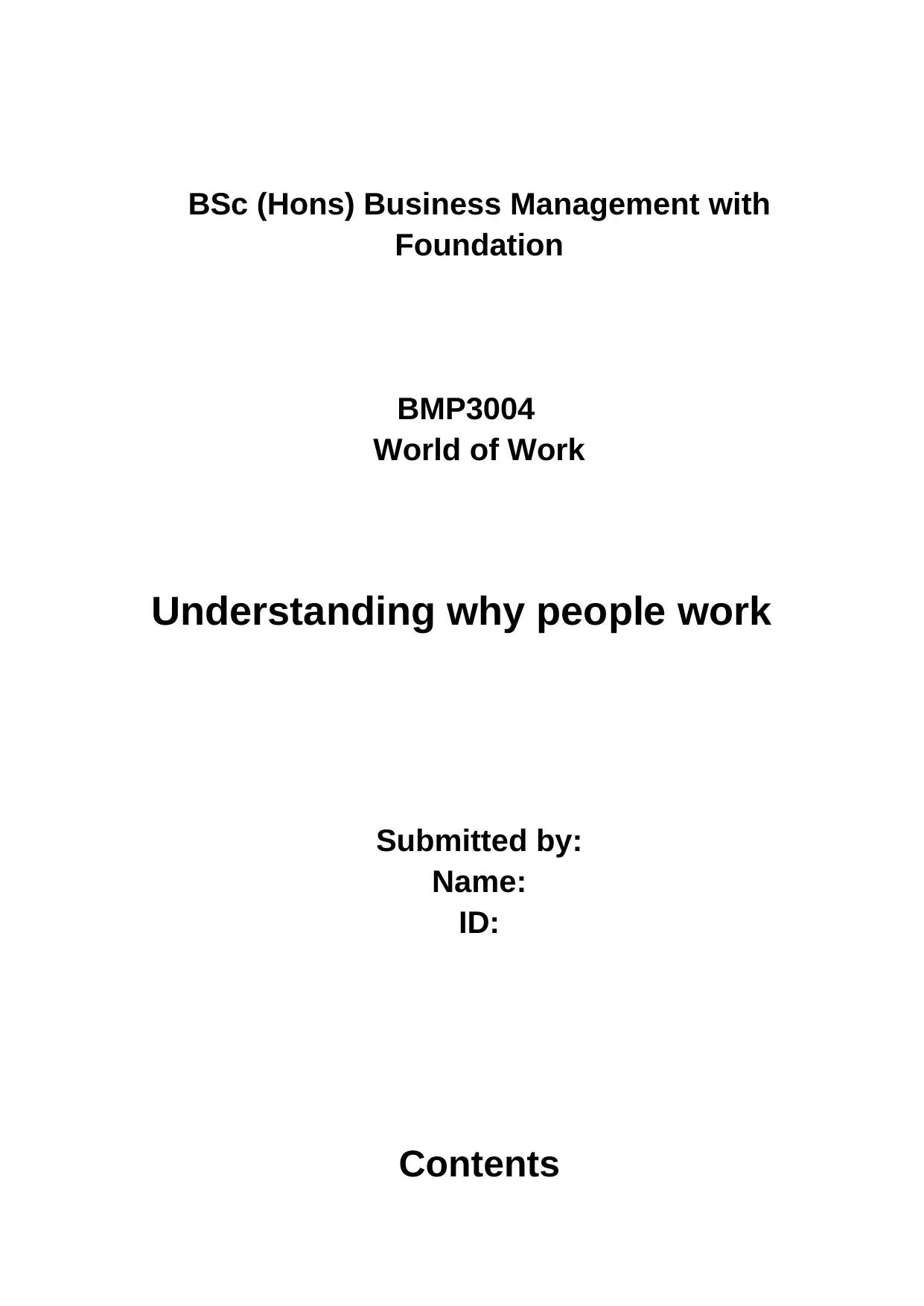
BSc (Hons) Business Management with
Foundation
BMP3004
World of Work
Understanding why people work
Submitted by:
Name:
ID:
Contents
Foundation
BMP3004
World of Work
Understanding why people work
Submitted by:
Name:
ID:
Contents
Paraphrase This Document
Need a fresh take? Get an instant paraphrase of this document with our AI Paraphraser
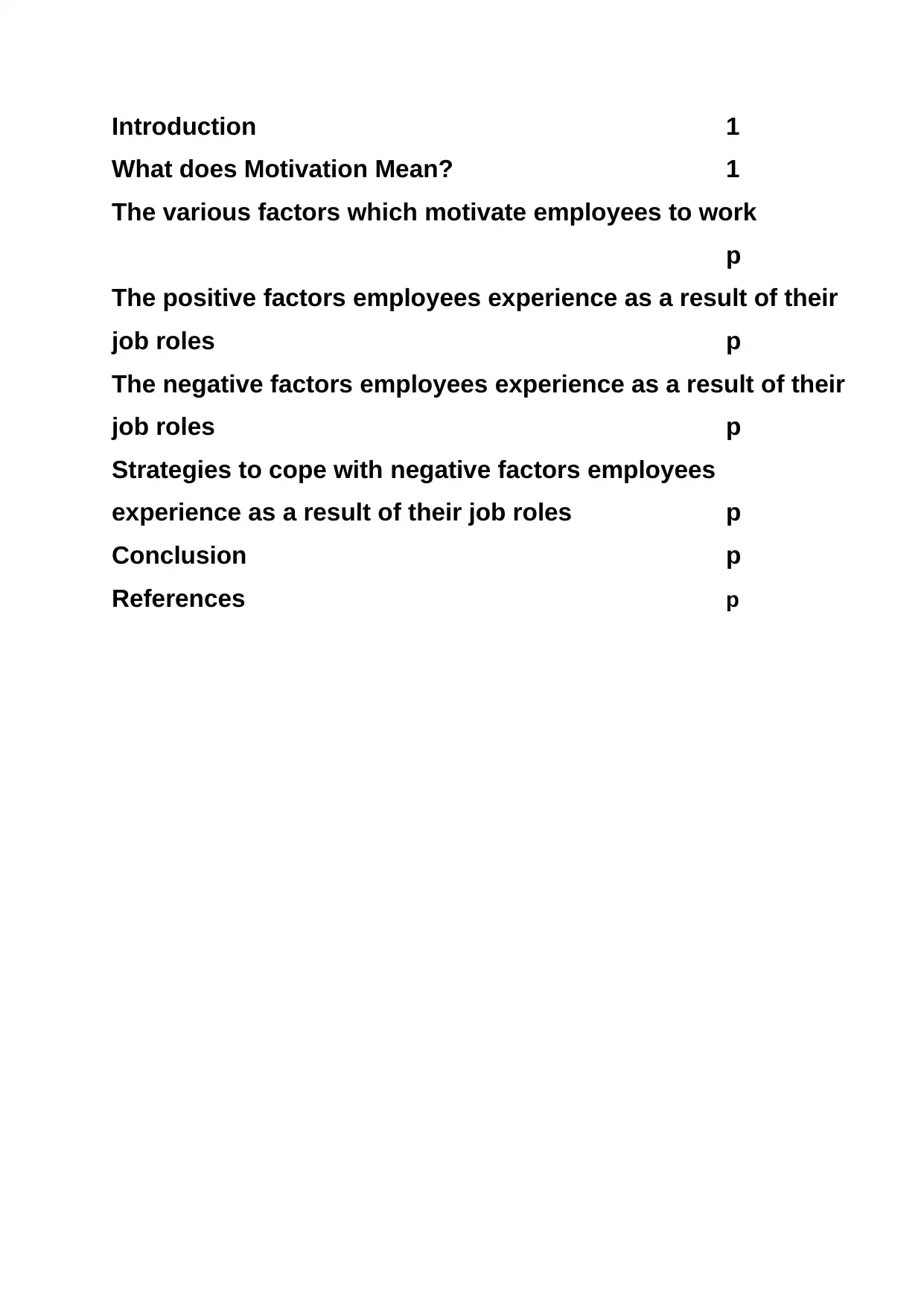
Introduction 1
What does Motivation Mean? 1
The various factors which motivate employees to work
p
The positive factors employees experience as a result of their
job roles p
The negative factors employees experience as a result of their
job roles p
Strategies to cope with negative factors employees
experience as a result of their job roles p
Conclusion p
References p
What does Motivation Mean? 1
The various factors which motivate employees to work
p
The positive factors employees experience as a result of their
job roles p
The negative factors employees experience as a result of their
job roles p
Strategies to cope with negative factors employees
experience as a result of their job roles p
Conclusion p
References p
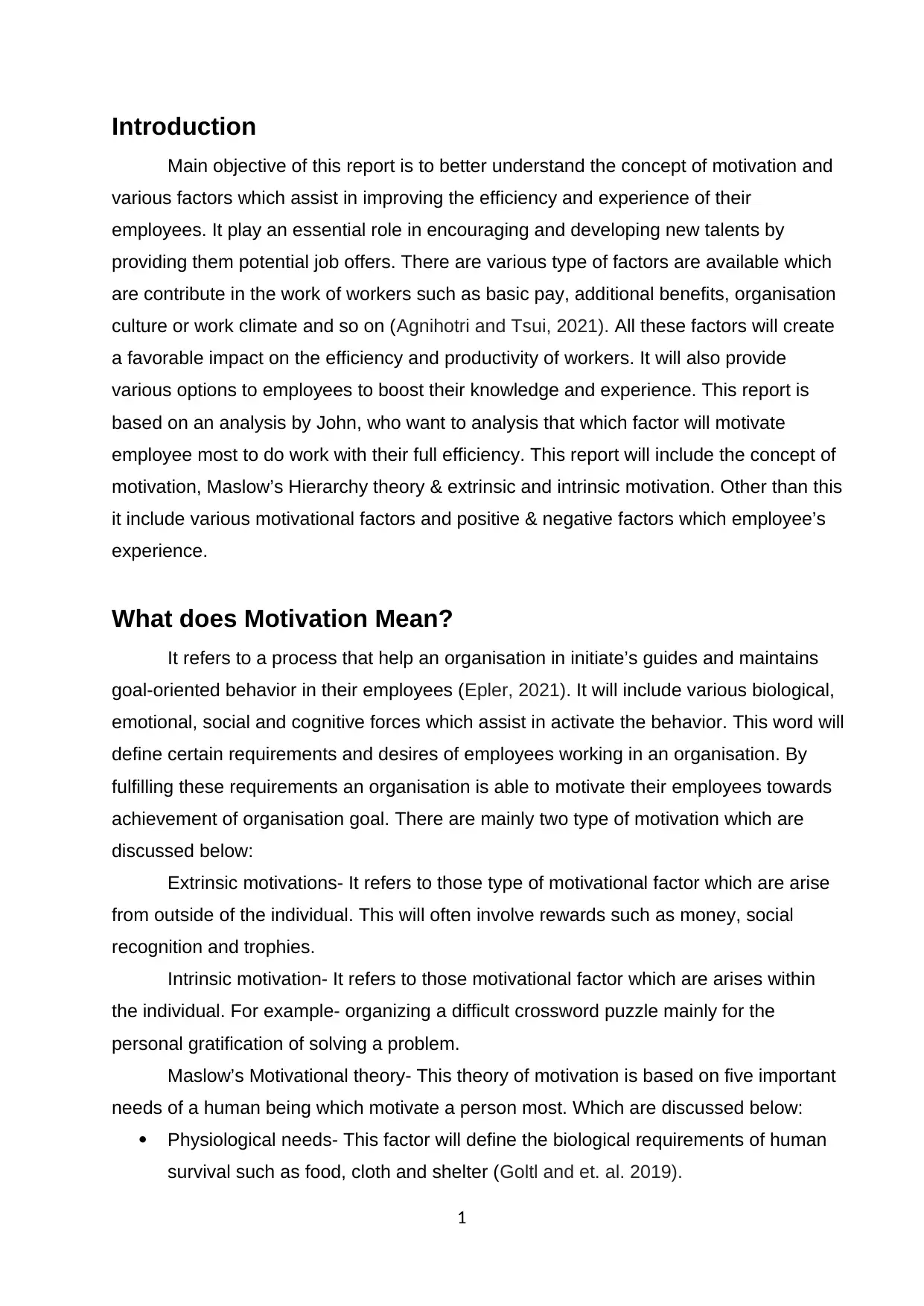
Introduction
Main objective of this report is to better understand the concept of motivation and
various factors which assist in improving the efficiency and experience of their
employees. It play an essential role in encouraging and developing new talents by
providing them potential job offers. There are various type of factors are available which
are contribute in the work of workers such as basic pay, additional benefits, organisation
culture or work climate and so on (Agnihotri and Tsui, 2021). All these factors will create
a favorable impact on the efficiency and productivity of workers. It will also provide
various options to employees to boost their knowledge and experience. This report is
based on an analysis by John, who want to analysis that which factor will motivate
employee most to do work with their full efficiency. This report will include the concept of
motivation, Maslow’s Hierarchy theory & extrinsic and intrinsic motivation. Other than this
it include various motivational factors and positive & negative factors which employee’s
experience.
What does Motivation Mean?
It refers to a process that help an organisation in initiate’s guides and maintains
goal-oriented behavior in their employees (Epler, 2021). It will include various biological,
emotional, social and cognitive forces which assist in activate the behavior. This word will
define certain requirements and desires of employees working in an organisation. By
fulfilling these requirements an organisation is able to motivate their employees towards
achievement of organisation goal. There are mainly two type of motivation which are
discussed below:
Extrinsic motivations- It refers to those type of motivational factor which are arise
from outside of the individual. This will often involve rewards such as money, social
recognition and trophies.
Intrinsic motivation- It refers to those motivational factor which are arises within
the individual. For example- organizing a difficult crossword puzzle mainly for the
personal gratification of solving a problem.
Maslow’s Motivational theory- This theory of motivation is based on five important
needs of a human being which motivate a person most. Which are discussed below:
Physiological needs- This factor will define the biological requirements of human
survival such as food, cloth and shelter (Goltl and et. al. 2019).
1
Main objective of this report is to better understand the concept of motivation and
various factors which assist in improving the efficiency and experience of their
employees. It play an essential role in encouraging and developing new talents by
providing them potential job offers. There are various type of factors are available which
are contribute in the work of workers such as basic pay, additional benefits, organisation
culture or work climate and so on (Agnihotri and Tsui, 2021). All these factors will create
a favorable impact on the efficiency and productivity of workers. It will also provide
various options to employees to boost their knowledge and experience. This report is
based on an analysis by John, who want to analysis that which factor will motivate
employee most to do work with their full efficiency. This report will include the concept of
motivation, Maslow’s Hierarchy theory & extrinsic and intrinsic motivation. Other than this
it include various motivational factors and positive & negative factors which employee’s
experience.
What does Motivation Mean?
It refers to a process that help an organisation in initiate’s guides and maintains
goal-oriented behavior in their employees (Epler, 2021). It will include various biological,
emotional, social and cognitive forces which assist in activate the behavior. This word will
define certain requirements and desires of employees working in an organisation. By
fulfilling these requirements an organisation is able to motivate their employees towards
achievement of organisation goal. There are mainly two type of motivation which are
discussed below:
Extrinsic motivations- It refers to those type of motivational factor which are arise
from outside of the individual. This will often involve rewards such as money, social
recognition and trophies.
Intrinsic motivation- It refers to those motivational factor which are arises within
the individual. For example- organizing a difficult crossword puzzle mainly for the
personal gratification of solving a problem.
Maslow’s Motivational theory- This theory of motivation is based on five important
needs of a human being which motivate a person most. Which are discussed below:
Physiological needs- This factor will define the biological requirements of human
survival such as food, cloth and shelter (Goltl and et. al. 2019).
1
⊘ This is a preview!⊘
Do you want full access?
Subscribe today to unlock all pages.

Trusted by 1+ million students worldwide
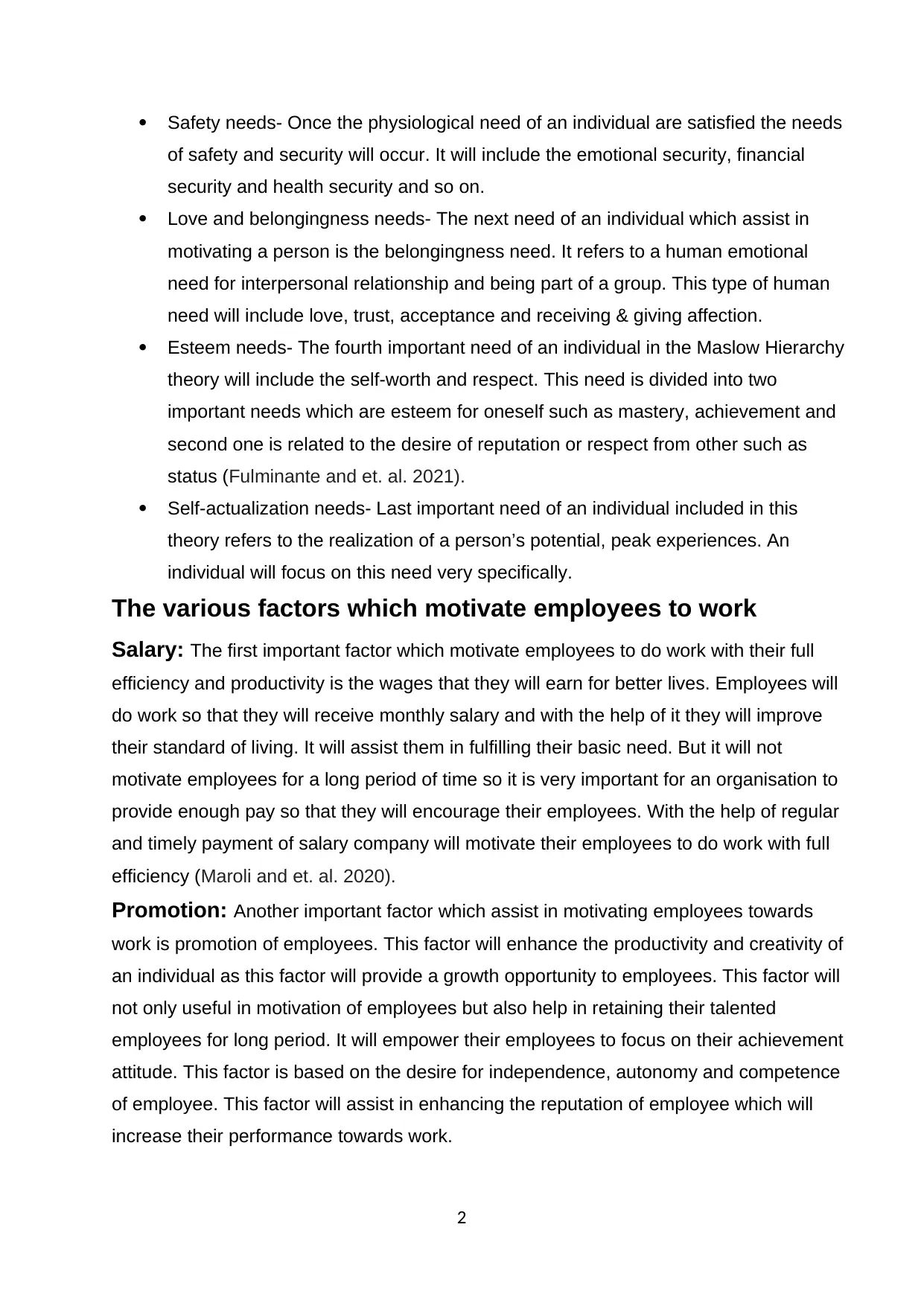
Safety needs- Once the physiological need of an individual are satisfied the needs
of safety and security will occur. It will include the emotional security, financial
security and health security and so on.
Love and belongingness needs- The next need of an individual which assist in
motivating a person is the belongingness need. It refers to a human emotional
need for interpersonal relationship and being part of a group. This type of human
need will include love, trust, acceptance and receiving & giving affection.
Esteem needs- The fourth important need of an individual in the Maslow Hierarchy
theory will include the self-worth and respect. This need is divided into two
important needs which are esteem for oneself such as mastery, achievement and
second one is related to the desire of reputation or respect from other such as
status (Fulminante and et. al. 2021).
Self-actualization needs- Last important need of an individual included in this
theory refers to the realization of a person’s potential, peak experiences. An
individual will focus on this need very specifically.
The various factors which motivate employees to work
Salary: The first important factor which motivate employees to do work with their full
efficiency and productivity is the wages that they will earn for better lives. Employees will
do work so that they will receive monthly salary and with the help of it they will improve
their standard of living. It will assist them in fulfilling their basic need. But it will not
motivate employees for a long period of time so it is very important for an organisation to
provide enough pay so that they will encourage their employees. With the help of regular
and timely payment of salary company will motivate their employees to do work with full
efficiency (Maroli and et. al. 2020).
Promotion: Another important factor which assist in motivating employees towards
work is promotion of employees. This factor will enhance the productivity and creativity of
an individual as this factor will provide a growth opportunity to employees. This factor will
not only useful in motivation of employees but also help in retaining their talented
employees for long period. It will empower their employees to focus on their achievement
attitude. This factor is based on the desire for independence, autonomy and competence
of employee. This factor will assist in enhancing the reputation of employee which will
increase their performance towards work.
2
of safety and security will occur. It will include the emotional security, financial
security and health security and so on.
Love and belongingness needs- The next need of an individual which assist in
motivating a person is the belongingness need. It refers to a human emotional
need for interpersonal relationship and being part of a group. This type of human
need will include love, trust, acceptance and receiving & giving affection.
Esteem needs- The fourth important need of an individual in the Maslow Hierarchy
theory will include the self-worth and respect. This need is divided into two
important needs which are esteem for oneself such as mastery, achievement and
second one is related to the desire of reputation or respect from other such as
status (Fulminante and et. al. 2021).
Self-actualization needs- Last important need of an individual included in this
theory refers to the realization of a person’s potential, peak experiences. An
individual will focus on this need very specifically.
The various factors which motivate employees to work
Salary: The first important factor which motivate employees to do work with their full
efficiency and productivity is the wages that they will earn for better lives. Employees will
do work so that they will receive monthly salary and with the help of it they will improve
their standard of living. It will assist them in fulfilling their basic need. But it will not
motivate employees for a long period of time so it is very important for an organisation to
provide enough pay so that they will encourage their employees. With the help of regular
and timely payment of salary company will motivate their employees to do work with full
efficiency (Maroli and et. al. 2020).
Promotion: Another important factor which assist in motivating employees towards
work is promotion of employees. This factor will enhance the productivity and creativity of
an individual as this factor will provide a growth opportunity to employees. This factor will
not only useful in motivation of employees but also help in retaining their talented
employees for long period. It will empower their employees to focus on their achievement
attitude. This factor is based on the desire for independence, autonomy and competence
of employee. This factor will assist in enhancing the reputation of employee which will
increase their performance towards work.
2
Paraphrase This Document
Need a fresh take? Get an instant paraphrase of this document with our AI Paraphraser
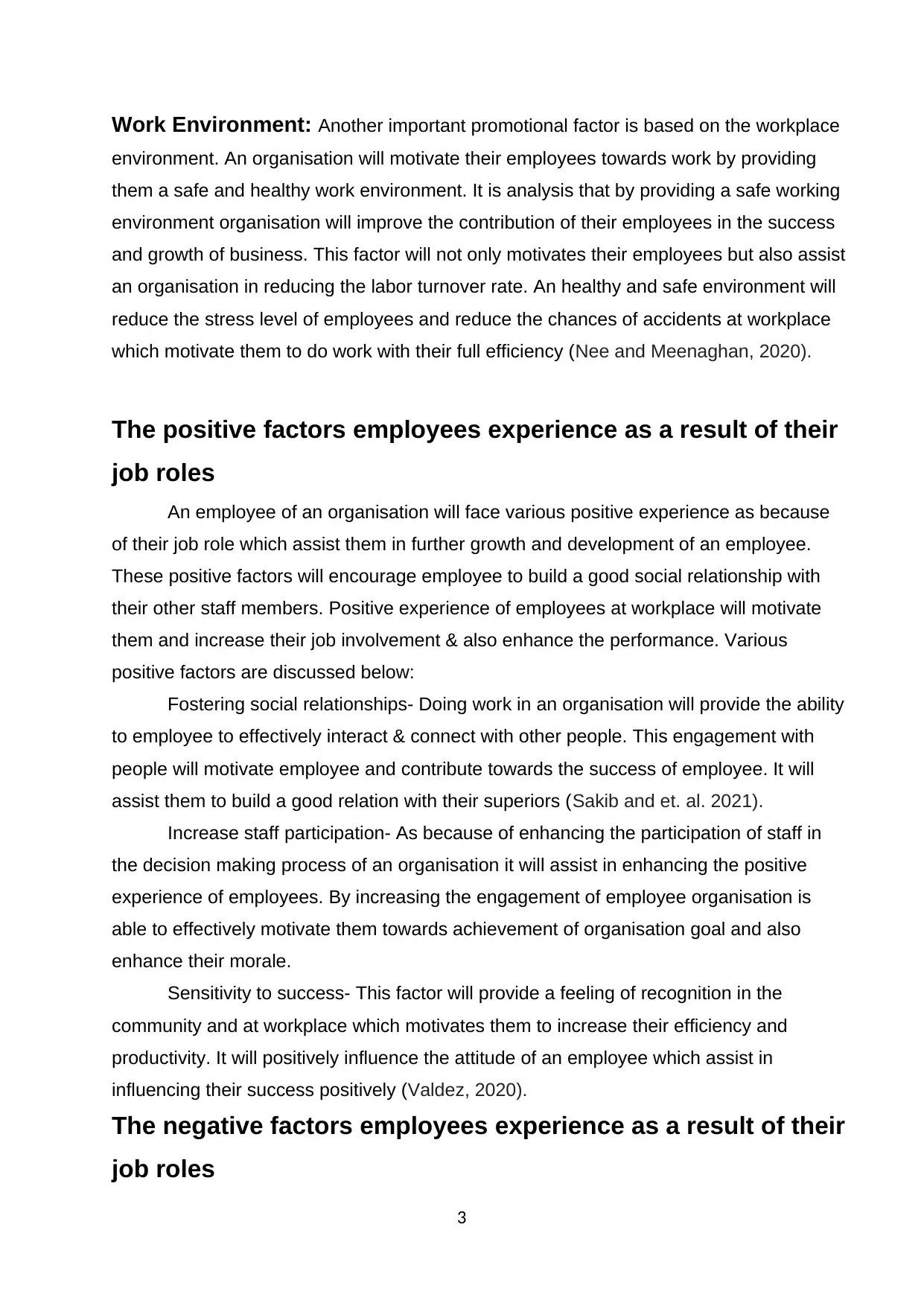
Work Environment: Another important promotional factor is based on the workplace
environment. An organisation will motivate their employees towards work by providing
them a safe and healthy work environment. It is analysis that by providing a safe working
environment organisation will improve the contribution of their employees in the success
and growth of business. This factor will not only motivates their employees but also assist
an organisation in reducing the labor turnover rate. An healthy and safe environment will
reduce the stress level of employees and reduce the chances of accidents at workplace
which motivate them to do work with their full efficiency (Nee and Meenaghan, 2020).
The positive factors employees experience as a result of their
job roles
An employee of an organisation will face various positive experience as because
of their job role which assist them in further growth and development of an employee.
These positive factors will encourage employee to build a good social relationship with
their other staff members. Positive experience of employees at workplace will motivate
them and increase their job involvement & also enhance the performance. Various
positive factors are discussed below:
Fostering social relationships- Doing work in an organisation will provide the ability
to employee to effectively interact & connect with other people. This engagement with
people will motivate employee and contribute towards the success of employee. It will
assist them to build a good relation with their superiors (Sakib and et. al. 2021).
Increase staff participation- As because of enhancing the participation of staff in
the decision making process of an organisation it will assist in enhancing the positive
experience of employees. By increasing the engagement of employee organisation is
able to effectively motivate them towards achievement of organisation goal and also
enhance their morale.
Sensitivity to success- This factor will provide a feeling of recognition in the
community and at workplace which motivates them to increase their efficiency and
productivity. It will positively influence the attitude of an employee which assist in
influencing their success positively (Valdez, 2020).
The negative factors employees experience as a result of their
job roles
3
environment. An organisation will motivate their employees towards work by providing
them a safe and healthy work environment. It is analysis that by providing a safe working
environment organisation will improve the contribution of their employees in the success
and growth of business. This factor will not only motivates their employees but also assist
an organisation in reducing the labor turnover rate. An healthy and safe environment will
reduce the stress level of employees and reduce the chances of accidents at workplace
which motivate them to do work with their full efficiency (Nee and Meenaghan, 2020).
The positive factors employees experience as a result of their
job roles
An employee of an organisation will face various positive experience as because
of their job role which assist them in further growth and development of an employee.
These positive factors will encourage employee to build a good social relationship with
their other staff members. Positive experience of employees at workplace will motivate
them and increase their job involvement & also enhance the performance. Various
positive factors are discussed below:
Fostering social relationships- Doing work in an organisation will provide the ability
to employee to effectively interact & connect with other people. This engagement with
people will motivate employee and contribute towards the success of employee. It will
assist them to build a good relation with their superiors (Sakib and et. al. 2021).
Increase staff participation- As because of enhancing the participation of staff in
the decision making process of an organisation it will assist in enhancing the positive
experience of employees. By increasing the engagement of employee organisation is
able to effectively motivate them towards achievement of organisation goal and also
enhance their morale.
Sensitivity to success- This factor will provide a feeling of recognition in the
community and at workplace which motivates them to increase their efficiency and
productivity. It will positively influence the attitude of an employee which assist in
influencing their success positively (Valdez, 2020).
The negative factors employees experience as a result of their
job roles
3
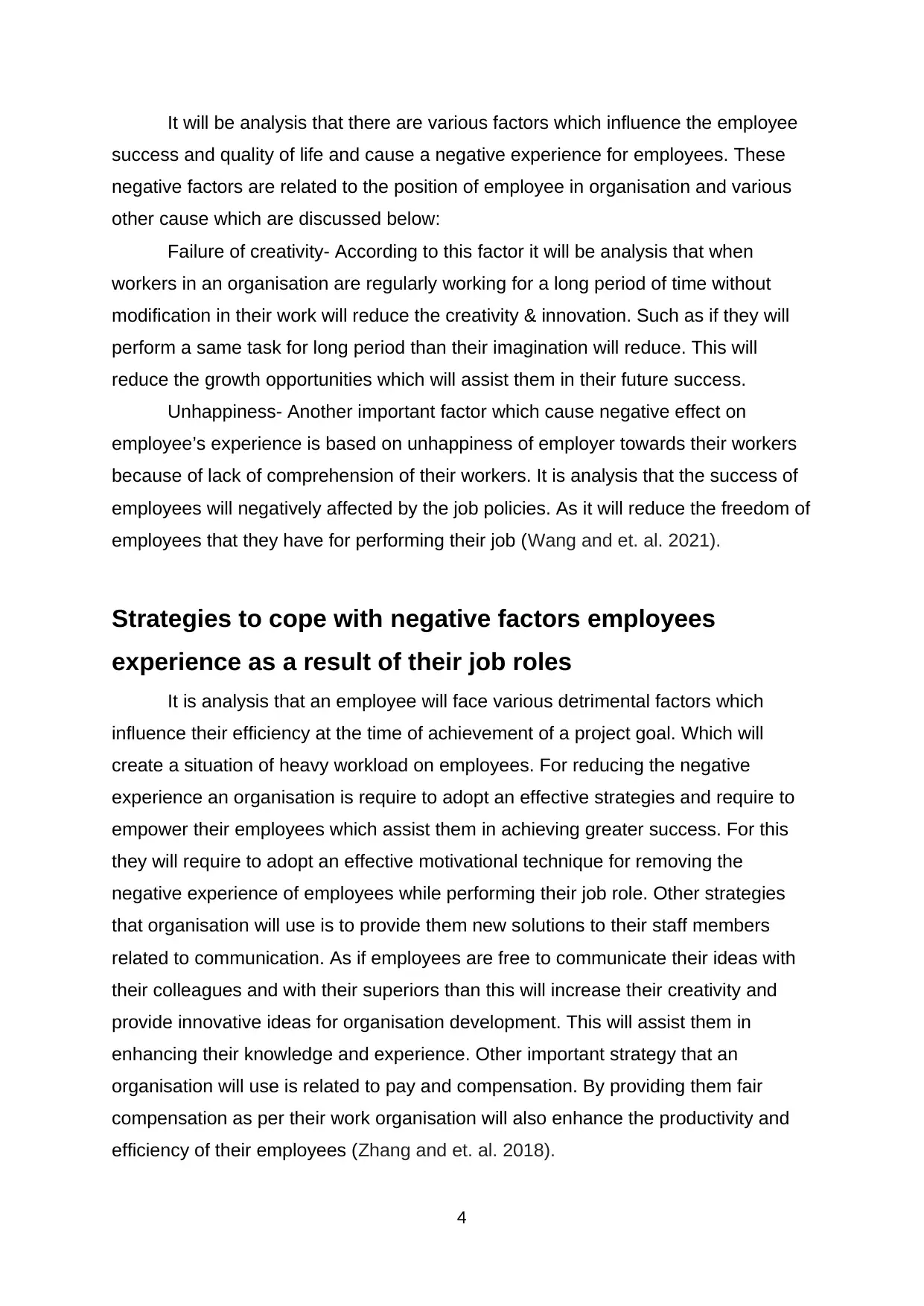
It will be analysis that there are various factors which influence the employee
success and quality of life and cause a negative experience for employees. These
negative factors are related to the position of employee in organisation and various
other cause which are discussed below:
Failure of creativity- According to this factor it will be analysis that when
workers in an organisation are regularly working for a long period of time without
modification in their work will reduce the creativity & innovation. Such as if they will
perform a same task for long period than their imagination will reduce. This will
reduce the growth opportunities which will assist them in their future success.
Unhappiness- Another important factor which cause negative effect on
employee’s experience is based on unhappiness of employer towards their workers
because of lack of comprehension of their workers. It is analysis that the success of
employees will negatively affected by the job policies. As it will reduce the freedom of
employees that they have for performing their job (Wang and et. al. 2021).
Strategies to cope with negative factors employees
experience as a result of their job roles
It is analysis that an employee will face various detrimental factors which
influence their efficiency at the time of achievement of a project goal. Which will
create a situation of heavy workload on employees. For reducing the negative
experience an organisation is require to adopt an effective strategies and require to
empower their employees which assist them in achieving greater success. For this
they will require to adopt an effective motivational technique for removing the
negative experience of employees while performing their job role. Other strategies
that organisation will use is to provide them new solutions to their staff members
related to communication. As if employees are free to communicate their ideas with
their colleagues and with their superiors than this will increase their creativity and
provide innovative ideas for organisation development. This will assist them in
enhancing their knowledge and experience. Other important strategy that an
organisation will use is related to pay and compensation. By providing them fair
compensation as per their work organisation will also enhance the productivity and
efficiency of their employees (Zhang and et. al. 2018).
4
success and quality of life and cause a negative experience for employees. These
negative factors are related to the position of employee in organisation and various
other cause which are discussed below:
Failure of creativity- According to this factor it will be analysis that when
workers in an organisation are regularly working for a long period of time without
modification in their work will reduce the creativity & innovation. Such as if they will
perform a same task for long period than their imagination will reduce. This will
reduce the growth opportunities which will assist them in their future success.
Unhappiness- Another important factor which cause negative effect on
employee’s experience is based on unhappiness of employer towards their workers
because of lack of comprehension of their workers. It is analysis that the success of
employees will negatively affected by the job policies. As it will reduce the freedom of
employees that they have for performing their job (Wang and et. al. 2021).
Strategies to cope with negative factors employees
experience as a result of their job roles
It is analysis that an employee will face various detrimental factors which
influence their efficiency at the time of achievement of a project goal. Which will
create a situation of heavy workload on employees. For reducing the negative
experience an organisation is require to adopt an effective strategies and require to
empower their employees which assist them in achieving greater success. For this
they will require to adopt an effective motivational technique for removing the
negative experience of employees while performing their job role. Other strategies
that organisation will use is to provide them new solutions to their staff members
related to communication. As if employees are free to communicate their ideas with
their colleagues and with their superiors than this will increase their creativity and
provide innovative ideas for organisation development. This will assist them in
enhancing their knowledge and experience. Other important strategy that an
organisation will use is related to pay and compensation. By providing them fair
compensation as per their work organisation will also enhance the productivity and
efficiency of their employees (Zhang and et. al. 2018).
4
⊘ This is a preview!⊘
Do you want full access?
Subscribe today to unlock all pages.

Trusted by 1+ million students worldwide
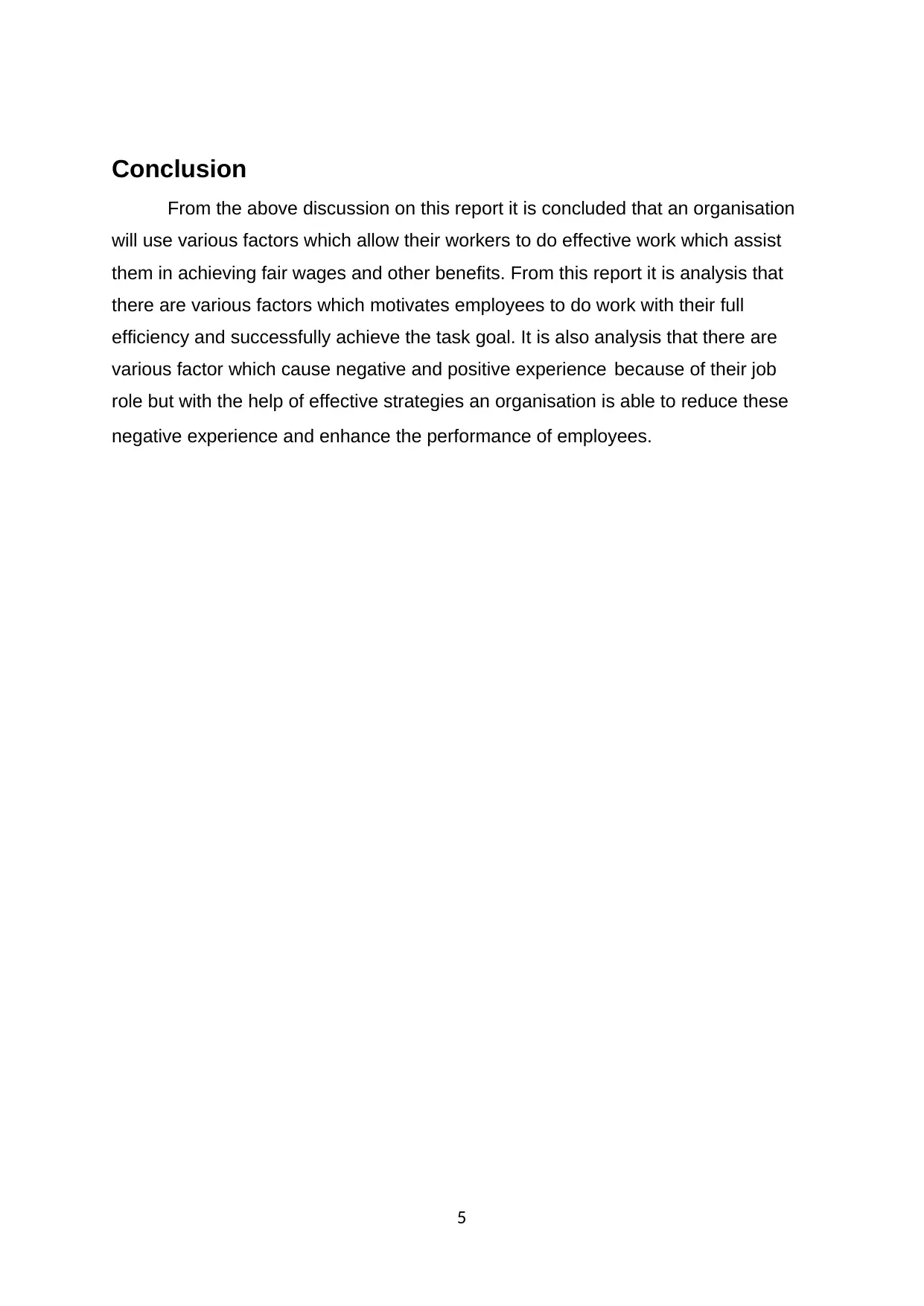
Conclusion
From the above discussion on this report it is concluded that an organisation
will use various factors which allow their workers to do effective work which assist
them in achieving fair wages and other benefits. From this report it is analysis that
there are various factors which motivates employees to do work with their full
efficiency and successfully achieve the task goal. It is also analysis that there are
various factor which cause negative and positive experience because of their job
role but with the help of effective strategies an organisation is able to reduce these
negative experience and enhance the performance of employees.
5
From the above discussion on this report it is concluded that an organisation
will use various factors which allow their workers to do effective work which assist
them in achieving fair wages and other benefits. From this report it is analysis that
there are various factors which motivates employees to do work with their full
efficiency and successfully achieve the task goal. It is also analysis that there are
various factor which cause negative and positive experience because of their job
role but with the help of effective strategies an organisation is able to reduce these
negative experience and enhance the performance of employees.
5
Paraphrase This Document
Need a fresh take? Get an instant paraphrase of this document with our AI Paraphraser
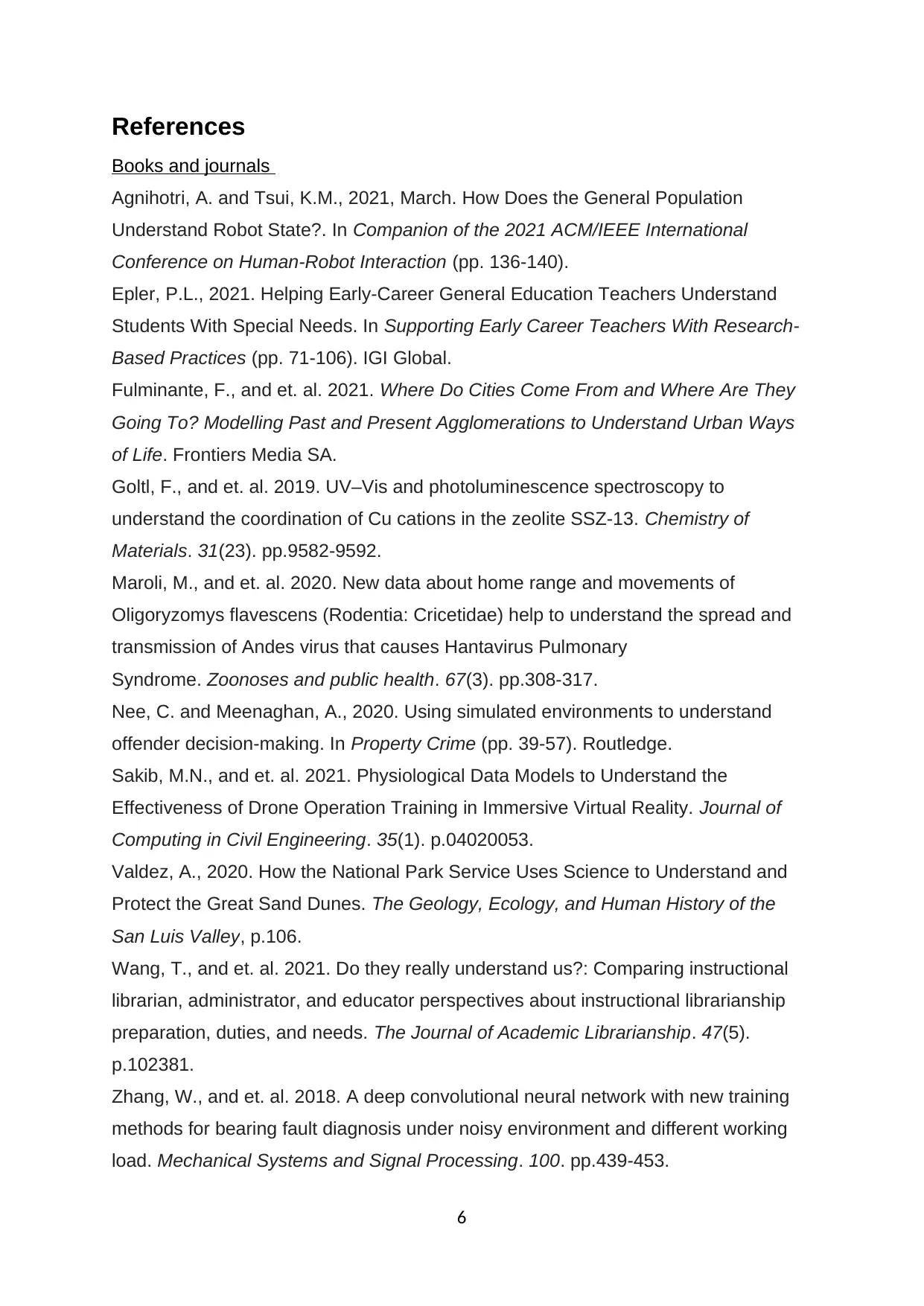
References
Books and journals
Agnihotri, A. and Tsui, K.M., 2021, March. How Does the General Population
Understand Robot State?. In Companion of the 2021 ACM/IEEE International
Conference on Human-Robot Interaction (pp. 136-140).
Epler, P.L., 2021. Helping Early-Career General Education Teachers Understand
Students With Special Needs. In Supporting Early Career Teachers With Research-
Based Practices (pp. 71-106). IGI Global.
Fulminante, F., and et. al. 2021. Where Do Cities Come From and Where Are They
Going To? Modelling Past and Present Agglomerations to Understand Urban Ways
of Life. Frontiers Media SA.
Goltl, F., and et. al. 2019. UV–Vis and photoluminescence spectroscopy to
understand the coordination of Cu cations in the zeolite SSZ-13. Chemistry of
Materials. 31(23). pp.9582-9592.
Maroli, M., and et. al. 2020. New data about home range and movements of
Oligoryzomys flavescens (Rodentia: Cricetidae) help to understand the spread and
transmission of Andes virus that causes Hantavirus Pulmonary
Syndrome. Zoonoses and public health. 67(3). pp.308-317.
Nee, C. and Meenaghan, A., 2020. Using simulated environments to understand
offender decision-making. In Property Crime (pp. 39-57). Routledge.
Sakib, M.N., and et. al. 2021. Physiological Data Models to Understand the
Effectiveness of Drone Operation Training in Immersive Virtual Reality. Journal of
Computing in Civil Engineering. 35(1). p.04020053.
Valdez, A., 2020. How the National Park Service Uses Science to Understand and
Protect the Great Sand Dunes. The Geology, Ecology, and Human History of the
San Luis Valley, p.106.
Wang, T., and et. al. 2021. Do they really understand us?: Comparing instructional
librarian, administrator, and educator perspectives about instructional librarianship
preparation, duties, and needs. The Journal of Academic Librarianship. 47(5).
p.102381.
Zhang, W., and et. al. 2018. A deep convolutional neural network with new training
methods for bearing fault diagnosis under noisy environment and different working
load. Mechanical Systems and Signal Processing. 100. pp.439-453.
6
Books and journals
Agnihotri, A. and Tsui, K.M., 2021, March. How Does the General Population
Understand Robot State?. In Companion of the 2021 ACM/IEEE International
Conference on Human-Robot Interaction (pp. 136-140).
Epler, P.L., 2021. Helping Early-Career General Education Teachers Understand
Students With Special Needs. In Supporting Early Career Teachers With Research-
Based Practices (pp. 71-106). IGI Global.
Fulminante, F., and et. al. 2021. Where Do Cities Come From and Where Are They
Going To? Modelling Past and Present Agglomerations to Understand Urban Ways
of Life. Frontiers Media SA.
Goltl, F., and et. al. 2019. UV–Vis and photoluminescence spectroscopy to
understand the coordination of Cu cations in the zeolite SSZ-13. Chemistry of
Materials. 31(23). pp.9582-9592.
Maroli, M., and et. al. 2020. New data about home range and movements of
Oligoryzomys flavescens (Rodentia: Cricetidae) help to understand the spread and
transmission of Andes virus that causes Hantavirus Pulmonary
Syndrome. Zoonoses and public health. 67(3). pp.308-317.
Nee, C. and Meenaghan, A., 2020. Using simulated environments to understand
offender decision-making. In Property Crime (pp. 39-57). Routledge.
Sakib, M.N., and et. al. 2021. Physiological Data Models to Understand the
Effectiveness of Drone Operation Training in Immersive Virtual Reality. Journal of
Computing in Civil Engineering. 35(1). p.04020053.
Valdez, A., 2020. How the National Park Service Uses Science to Understand and
Protect the Great Sand Dunes. The Geology, Ecology, and Human History of the
San Luis Valley, p.106.
Wang, T., and et. al. 2021. Do they really understand us?: Comparing instructional
librarian, administrator, and educator perspectives about instructional librarianship
preparation, duties, and needs. The Journal of Academic Librarianship. 47(5).
p.102381.
Zhang, W., and et. al. 2018. A deep convolutional neural network with new training
methods for bearing fault diagnosis under noisy environment and different working
load. Mechanical Systems and Signal Processing. 100. pp.439-453.
6
1 out of 8
Related Documents
Your All-in-One AI-Powered Toolkit for Academic Success.
+13062052269
info@desklib.com
Available 24*7 on WhatsApp / Email
![[object Object]](/_next/static/media/star-bottom.7253800d.svg)
Unlock your academic potential
Copyright © 2020–2025 A2Z Services. All Rights Reserved. Developed and managed by ZUCOL.



